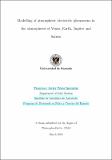Por favor, use este identificador para citar o enlazar a este item:
http://hdl.handle.net/10261/161031COMPARTIR / EXPORTAR:
 SHARE
BASE SHARE
BASE
|
|
| Visualizar otros formatos: MARC | Dublin Core | RDF | ORE | MODS | METS | DIDL | DATACITE | |

| Título: | Modelling of atmospheric electricity phenomena in the atmospheres of Venus, Earth, Jupiter and Saturn |
Autor: | Pérez-Invernón, Francisco J. | Director: | Gordillo Vázquez, Francisco J. CSIC ORCID; Luque, Alejandro CSIC ORCID | Palabras clave: | Planetary atmospheres Atmospheric models Transient luminous events (TLEs) |
Fecha de publicación: | 22-mar-2018 | Editor: | Universidad de Granada CSIC - Instituto de Astrofísica de Andalucía (IAA) |
Resumen: | In this doctoral thesis we describe the development and results
of several models to study electricity phenomena in the atmospheres
of Venus, Earth, Jupiter and Saturn. In addition, in
the context of the future launch of ASIM (ESA) in 2018 and
TARANIS (CNES) in 2019, we present two methods to analyze
the optical signals emitted by Transient Luminous Events
(TLEs) from space-based photometers.
We have developed two electrodynamical models to simulate the
inception and evolution of halos and elves in planetary atmospheres.
These models have been coupled with di erent sets of
chemical reactions to describe TLEs in the upper atmospheres
of Venus, Earth, Jupiter and Saturn. The terrestrial versions
of these models have allowed us to quantify the local chemical
impact of halos and elves in the atmosphere of the Earth. We
have used these results together with the TLE occurrence rate
reported by ISUAL (NSPO) to estimate the global impact of
these events in the chemistry of the terrestrial mesosphere. We
have also investigated the similarities and di erences between
elves triggered by di erent types of lightning discharges, such
as cloud-to-ground (CG) discharges, Compact Intracould Discharges
(CIDs) and Energetic In-cloud Pulses (EIPs). Finally,
the model of halos has been used to calculate the quasielectrostatic
eld produced by this type of TLE at ground level. We have compared this result with measurements of electric elds from thunderstorms. The existence of lightning in Venus is still unclear. We have investigated the possibility of detecting Venusian TLE as an indirect evidence of the existence of Venusian lightning discharges. The Venusian versions of the TLEs models have been useful to predict the possible inception of halos and elves in Venus. According to our results, these Venusian TLEs could emit light in a wide range of frequencies of the optical spectrum. Some of these optical emissions would be produced in the 557 nm line. The Akatsuki spacecraft (JAXA), currently orbiting Venus since December 2015, could detect bursts of light in this spectral line. In the case of Jupiter and Saturn, the three-dimensional version of the elve model has enabled us to study the shape and intensity of the predicted optical emissions in the upper atmosphere of the giant gaseous planets depending on the latitude, lightning channel inclination and upper atmospheric composition. In addition, we have concluded that the optical ashes in the Saturnian and Jovian atmosphere detected by several spacecraft as the Voyagers (NASA) and Cassini (NASA, ESA and ASI) come from lightning rather than from elves. However, it is possible that TLEs in the giant planets are triggered by the lightning activity in the atmospheres of Saturn and Jupiter. The models developed in this thesis could help unveil such new optical transient events in coordination with future dedicated instruments to search for such phenomena. We have used a Full Wave Method to investigate the propagation of Very Low Frequency (VLF) waves through planetary atmospheres. In the case of Earth, we have calculated the transfer function of the curved Earth-ionosphere waveguide. This transfer function is useful to analyze distant sources of electromagnetic pulses. This model has also been particularized to the case of whistler wave propagation through the Venusian atmosphere. The comparison of our results with signals reported by the Pioneer Venus Orbiter (PVO) of NASA and Venus Express (VEX) of ESA has allowed us to derive the rate of occurrence and energy released by hypothetical Venusian lightning radiating electromagnetic waves. Finally, we have used the simulated optical emissions of halos and elves to develop two methods to analyze the emitting source from optical signals recorded by space-based photometers onboard the future space missions ASIM and TARANIS to study atmospheric electricity in the Earth atmosphere. These methods can be used to obtain the temporal evolution of the number of photons emitted by elves and to deduce the reduced electric eld in halos and elves. We have applied one of these methods to the signals reported by GLIMS (JAXA). |
URI: | http://hdl.handle.net/10261/161031 |
| Aparece en las colecciones: | (IAA) Tesis |
Ficheros en este ítem:
| Fichero | Descripción | Tamaño | Formato | |
|---|---|---|---|---|
| IAA_Tesis_2018_FJ_Perez_Invernon.pdf | 44 MB | Adobe PDF |  Visualizar/Abrir |
CORE Recommender
Page view(s)
261
checked on 22-abr-2024
Download(s)
149
checked on 22-abr-2024
Google ScholarTM
Check
NOTA: Los ítems de Digital.CSIC están protegidos por copyright, con todos los derechos reservados, a menos que se indique lo contrario.
